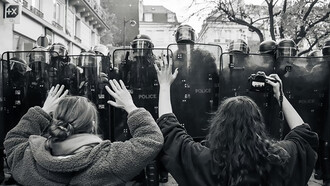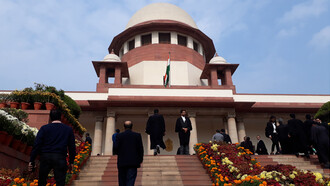The agreement between Israel and Lebanon demarcating their maritime border is a historic achievement between two countries in conflict, one that could usher in additional agreements on other issues; a potent strategy that could dispel centuries of distrust.
I grew up in San Miguel de Tucumán, a city in northern Argentina. At the beginning of the 1900s, Tucumán received numerous immigrants from Arab countries, among them my father who emigrated from Lebanon. Tucumán was also home to a robust Jewish population that had fled persecution during WWII. It was in Tucumán where I witnessed, as an adolescent, a microcosm of peaceful co-existence and collaboration between Arabs and Jews. Dozens of businesses owned by Arabs and Jews lined the main street of the city’s business center. Many of these businesses continue to co-exist today.
In many cases, Arab and Jewish business owners collaborated with each other because of shared commercial interests. Hugo Japaze, an Argentinian physician whose father had a well-known store on that street, recently told me, “Both Arabs and Jews were immigrants in a new land, and they realized that they had much more to gain by working together in a friendly atmosphere than by reviving old animosities.”
In the 1950s, my father, together with two friends, founded what they called the “Cultural Atheneum Gibran Khalil Gibran,” named after the famous Lebanese poet and writer. Its main purpose was to organize lectures by noted speakers: Nobel Prize in Literature winner Miguel Angel Asturias, Claudio Sánchez Albornoz, Prime Minister of the Spanish Republican government in exile during Francisco Franco’s dictatorship, and famous Argentinean writers such as Ernesto Sábato and Ezequiel Martínez Estrada.
These events were popular and attended by students, professors, and the general public. The lectures took place at the Sociedad Sirio Libanesa (Syrian and Lebanese Society). At the time, there was considerable unease among the Society’s directors about whether or not to include Jewish intellectuals. Because of my father’s untiring efforts, Jewish students and teachers were allowed to participate in the events at the Society, something that had never happened before. In both those cases, common commercial and cultural interests promoted the collaboration between Arabs and Jews leading to a peaceful relationship between both communities.
A narrative is a group of stories that helps people make sense of their experiences and create a meaningful view of the world. If a common narrative could be created then, can one be created now in the Middle East based on the common need for peace? I believe it can, but only if each side of the conflict is able to see the other as human beings with the same need for safety and sovereignty.
Uri Avnery, the late leading peace activist in Israel, argued that this lack of a common narrative was the main obstacle to peace in the Middle East. “Reconciliation is impossible if either side is totally oblivious to the narrative of the other, their history, beliefs, perceptions, myths,” he said. And added, “Only if the American intermediaries, neutral or otherwise, understand both can they contribute to furthering peace.”
However, American diplomats and Arab and Israeli officials have so far proven to be ineffective and one-sided in their approach to solving the long conflict between Palestinians and Israelis. I believe that if in my hometown, thousands of miles from the Middle East, a common narrative could be found based on shared commercial and cultural interests, the same could occur now to promote peace between Arabs and Jews.
While health initiatives alone cannot secure peace, particularly where political, cultural psychological and religious tensions abound, they often serve as a useful point of contact between conflicting parties. Bi-national health programs have served to expand cooperation between divided peoples, demonstrating the power of citizens’ communication in hostile political environments.
During the 1980s in Latin America, violent clashes between Nicaragua's Contras and Sandinistas roused the interest of the Pan American Health Organization’s (PAHO), the regional office of the World Health Organization (WHO). As a result, PAHO implemented the “Health as a Bridge for Peace” strategy aimed at providing health care to populations living in war-torn areas in Latin America.
Their work resulted in so-called Days of Tranquility in El Salvador and Peru, during which thousands of children were vaccinated against polio, diphtheria, whooping cough, tetanus and measles. Most notably, PAHO's activities enjoyed the backing of government officials and rebel guerrilla forces. Concern for public health was a common ground.
The same approach has been used in the Middle East. Since its founding in 1988, the Association of Israeli-Palestinian Physicians for Human Rights has created two funds to address the medical neglect of Palestinian migrant workers' children: The Palestinian Children's Medical Care Fund and The Children of Foreign Workers Medical Fund. The organization also conducts training activities for Palestinian health professionals and has become a leading advocate for the health and human rights in the region. Since the 1993 Oslo Accords, several new health groups were created, which provided health services to the Palestinians.
In 1995, the late King Hussein of Jordan invited officials from the Canada International Scientific Exchange Programme (CISEPO) to conduct a series of activities to foster better collaboration between Arab and Israeli doctors. The high incidence of hearing loss shared by Jordanians and Israelis was the basis of a project to provide audiology tests for infants, which to date has screened and habilitated thousands of infants. The program was later expanded to promote youth health, maternal nutrition, and infectious disease management.
Canada, Israel and Jordan have enjoyed a good amount of academic exchange, and Israelis and Palestinians have worked together on publications and scientific symposiums.
Cooperation is not limited to the medical field. In music, two orchestras formed by Arab and Israeli musicians have been performing in several countries: one, the Orchestra for Peace, created by the late Argentine musician Miguel Angel Estrella, and the other, the West-Eastern Divan Orchestra co-founded by Daniel Barenboim, the Argentine-born Israeli conductor and Edward Said, the late Palestinian-American professor.
Contributing to those peace efforts is the work carried out at the Tabeetha school, the only Church of Scotland school in the world. The school, located forty miles from the Gaza Strip, in Israel’s port of Jaffa, welcomes all children, regardless of race, nationality, gender, or religion. “It doesn’t matter what religion they come from,” said Margaret MacDonald, the school’s principal, “you can’t tell whether they’re Jewish, they are Muslim, they’re nothing – they are all treated exactly the same.”
So much money has been spent in trying, vainly, to hurt the other side that a smaller effort could be devoted to creating an atmosphere conducive to peace that will have repercussions in all countries in the region. The new agreement between Israel and Lebanon is a small but valuable contribution to peace in the region.
Peace between Israelis and Palestinians will not be achieved overnight, but it is only through a massive effort involving the citizenry that reconciliation can occur between both peoples. In a region plagued by mistrust, deep-rooted fear and violence, building citizen bridges are the best antidote to war. These kinds of actions, by themselves, will not bring a permanent solution to the conflict, but they will create the conditions that will make peace in the Middle East not only possible but inevitable.















